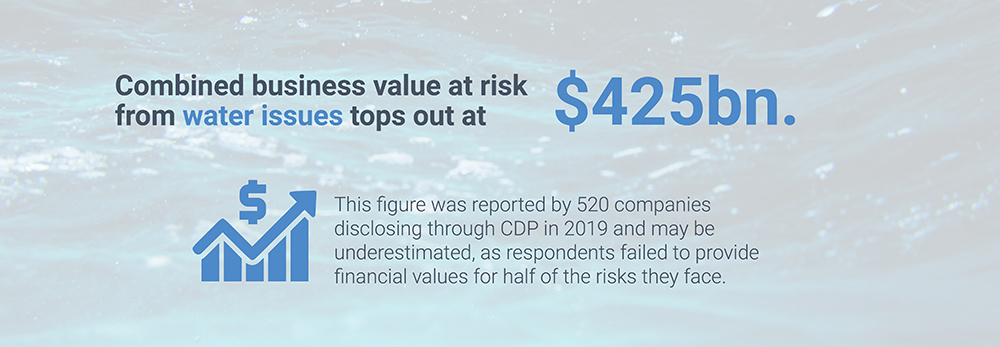CDP Global Water Report 2019
Cleaning up their act: Are companies responding to the risks and opportunities posed by water pollution?
The World Bank has identified water pollution as an ‘invisible crisis’ threatening societies and economies, but companies are not taking the issue seriously enough.
The CDP Global Water Report 2019 analyses the data disclosed through CDP by 2,433 companies in 2019. It finds that companies are not doing enough to tackle water pollution - and reveals the tangible business case for immediate action.
Our analysis shows that less than half of the disclosing companies regularly measure and monitor their water discharges, and only 12% have set a pollution reduction target and/or goal. We found that many companies underestimate the associated risks of water pollution, with only 10% reporting it a top risk.
There is not enough freshwater to meet global needs, and 80% of wastewater is still released untreated. Nearly half the rivers in the USA are unfit for swimming, fishing, and drinking; a third of those in Latin America, Africa, and Asia are affected by severe pathogen pollution; and almost 60% of Europe’s surface water is polluted.
Companies across industrial sectors – including textiles, food and beverage,and manufacturing – are contributing to the problem. The obligations to act are not only ethical, but also legal and financial. Regulators and consumers are ratchetting up the pressure on companies to eliminate waste. Yet companies are still underestimating the economic, ecological and health implications of water pollution.
Companies that get ahead of the trend for tighter environmental protection and mounting consumer concern will be those that reap the rewards.
There are many opportunities for companies to act and seize the benefits of the transition to a water-secure future. The economic imperatives are clear. A combined value at risk of US$425 billion was reported through CDP in 2019; this is likely to be an underestimate as financial estimates were given for only half of the risks reported.
Many companies are realizing this, and 329 more companies disclosed their water security data through CDP in 2019 than in 2018. However, over 2,500 companies still failed to meet the request for data.

By monitoring their water impacts, companies can begin to manage associated risks involving regulation, reputation and potential litigation.
Reporting on water issues allows companies, investors and governments to make smarter decisions. A boost to consumer and investor confidence may offer financial returns. Harnessing wastewater is an untapped opportunity that can improve overall business efficiency.
As COVID-19 presents new and critical global challenges, it is more important than ever that companies protect our vital resources, seize the related business opportunities, and measure and manage long-term risks to ensure resilience to future shocks.
The transition to a water-secure, zero carbon future is a source of opportunity for innovation, market differentiation and brand value. To succeed, companies will need to look beyond the “business-as-usual” responses to pollution management and pursue plans to grow differently.
While there are seeds of best practice, we have a long way to go before the effective elimination and management of corporate water pollution moves to the mainstream. A critical starting point is monitoring and reporting water risks and impacts through CDP, to enable companies to set and make progress against ambitious targets.
